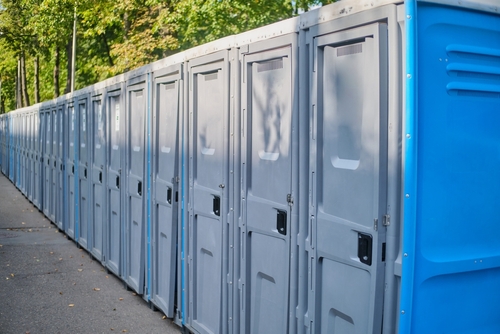Portable Toilet Winter Care: Ensuring Functionality and Comfort
Winter presents unique challenges for portable toilet usage, especially in areas with freezing temperatures and...
28 May 2024

Maintaining cleanliness and sanitation standards on construction sites is essential for the health, safety, and well-being of workers. Portable toilets are a critical component of this effort, requiring regular servicing, effective waste management, and thorough disinfection procedures. Here, we discuss best practices for ensuring that hygiene and sanitation standards are upheld in portable toilets on construction sites.
A consistent servicing schedule is crucial for maintaining the cleanliness and functionality of portable toilets. Here’s how to implement an effective servicing routine:
Frequent Cleaning: Portable toilets should be cleaned at least once a week, depending on the number of workers and the frequency of use. High-traffic sites may require more frequent servicing. Cleaning involves replenishing toilet paper, soap, and hand sanitiser, as well as removing waste and disinfecting surfaces.
Inspection and Maintenance: Regular inspections help identify any issues such as leaks, blockages, or damage to the toilet units. Prompt maintenance ensures that toilets remain functional and safe for use. Inspections should also check for adequate ventilation to reduce odours.
Scheduled Waste Removal: Establish a schedule for waste removal based on the capacity of the toilet units and the number of users. Regular waste removal prevents overflows and maintains hygienic conditions.
Effective waste management is critical for maintaining sanitation standards on construction sites. Implementing proper waste management protocols helps ensure safe and hygienic disposal:
Safe Disposal: Ensure that waste is collected and disposed of by licensed waste management companies. These companies should follow environmental regulations and guidelines to prevent contamination and environmental harm.
Separation of Waste Types: If your construction site generates different types of waste, including hazardous materials, ensure that waste is properly separated and disposed of according to regulations. This prevents cross-contamination and promotes environmental safety.
Waste Reduction: Encourage practices that reduce waste generation, such as using biodegradable or recyclable materials. This not only supports hygiene but also aligns with sustainable practices.
Disinfection is a key aspect of maintaining hygiene standards in portable toilets. Regular disinfection procedures help prevent the spread of bacteria and viruses:
High-Touch Areas: Focus on disinfecting high-touch areas such as door handles, toilet seats, flush handles, and handwashing stations. These areas are most likely to harbour germs and require frequent disinfection.
Use of Effective Disinfectants: Use EPA-approved disinfectants that are effective against a broad spectrum of pathogens. Follow the manufacturer’s instructions for dilution, application, and contact time to ensure maximum efficacy.
Deep Cleaning: Schedule periodic deep cleanings to thoroughly disinfect the entire unit, including walls, floors, and ceilings. Deep cleaning involves more intensive procedures and may require specialised equipment and cleaning agents.
In addition to maintaining the cleanliness of portable toilets, promoting good hygiene practices among workers is essential:
Hand Hygiene: Ensure that portable toilets are equipped with handwashing stations or hand sanitiser dispensers. Encourage workers to wash their hands thoroughly after using the toilet and before eating or drinking.
Signage and Education: Place clear signage in and around the toilets to remind workers of the importance of hand hygiene and proper toilet use. Providing education on hygiene practices can also help reinforce these messages.
Accessibility: Position portable toilets in easily accessible locations throughout the construction site. This encourages regular use and prevents workers from seeking alternative, less sanitary options.
Choosing a reliable service provider like Challenger Site Services ensures that portable toilets are maintained to the highest standards:
Comprehensive Services: Partner with a provider that offers comprehensive services, including regular cleaning, waste removal, and maintenance. This ensures that all aspects of toilet hygiene and functionality are covered.
Responsive Support: A reliable service provider should offer responsive support to address any issues promptly. This includes emergency cleaning or repairs to maintain sanitation standards.
Quality Assurance: Ensure that the service provider follows strict quality assurance protocols and uses high-quality cleaning products and equipment. This guarantees consistent and effective maintenance.
Maintaining cleanliness and sanitation standards in portable toilets on construction sites is essential for worker health and safety. By implementing regular servicing schedules, effective waste management protocols, and thorough disinfection procedures, you can ensure that hygiene standards are upheld. Partnering with a reliable service provider like Challenger Site Services further guarantees that your portable toilets are maintained to the highest standards. Contact us today to learn more about our comprehensive sanitation solutions for construction sites and how we can help you maintain a clean and hygienic work environment.
Winter presents unique challenges for portable toilet usage, especially in areas with freezing temperatures and...
Accessible Portable Toilets: Why They Matter for Events and Construction Sites When planning events or...
When hosting an event, managing a construction site, or organising an outdoor gathering, it’s crucial...
Click and drag to see more